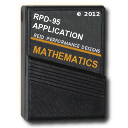Newton's Method
This program searches for a root of a function. It converges for most functions, but in some cases goes into oscillation. To prevent the program from running indefinitely, you can specify a limit for the number of iterations.
Introduction
The Newton's method program uses the Newton-Raphson technique to search for a root of a function. For many functions, any initial guess leads quickly to a root. However, an initial guess near the desired root usually shortens execution time.You must enter the function as a subroutine in program memory before running the program. When the program calls the subroutine, the value for the independent variable is available in both the display and data register A (000).
If the function is a polynomial, you can use the Q-D method to obtain an initial guess.
Reference
Handbook of Engineering Fundamentals, Ovid W. Eshbach, John Wiley & Sons, Inc., New York, 1954, pp. 2-16.For the Beginning Programmer
Before using the Newton's method program, you must store the function as a subroutine in program memory.If you are not familiar with keystroke programming, refer to the following chapters in the RPD-95 Programming Guide for instructions.
- "Working with Programs on the RPD-95"
- "Using Calculator Keystrokes in a Program"
- "Controlling the Sequence of Operations"
Rules for Storing the Function
When you store the function as a subroutine, follow these rules.The subroutine must be labeled fx (lowercase only).
- Anytime the subroutine needs the independent variable, use a RCL A or RCL 000 instruction.
- The subroutine must terminate with a RTN instruction.
Starting the Program
To start the program that uses Newton's method:- Store the function as a subroutine, following the rules listed above.
- If the subroutine involves any of the trig functions, select the angle units you want to use.
- Select { ZRO } from the
MATHEMATICS menu.
The calculator displays the FUNCTION ZEROS menu. - Press { NTN }.
The program displays:

- Enter the initial guess and press { xo }.
- Enter the allowable error and press { err }.
- Enter the maximum number of iterations and press { #it }.
Finding the Root
After you enter the parameters for the program, you can find the root of the function you have stored.- Press { EOD }.
If the program is able to find a root within the number of iterations you specified, it displays:
 where the
value shown is the root found within the allowable error.
where the
value shown is the root found within the allowable error.
If the program cannot find a root within the specified number of iterations, it displays:

• To display delta, press { del }.
• To perform additional iterations, press { #it }, and press { EOD }. The program continues the calculations for the number of iterations you specify.
☚ Back


